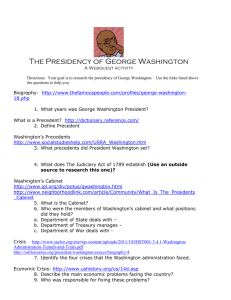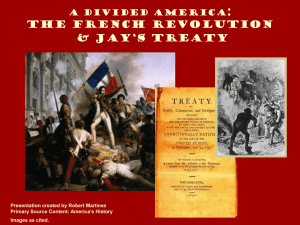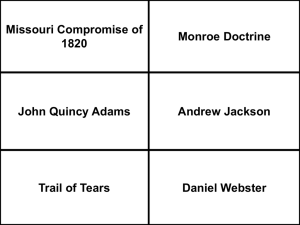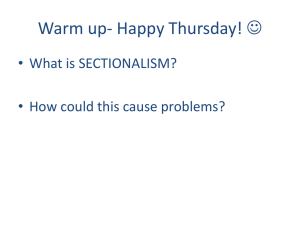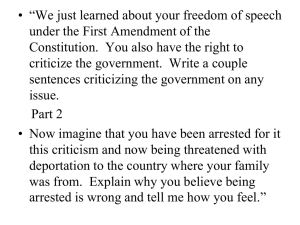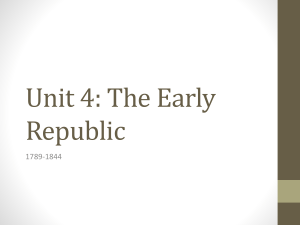America In A Changing World: 1793-1799
advertisement
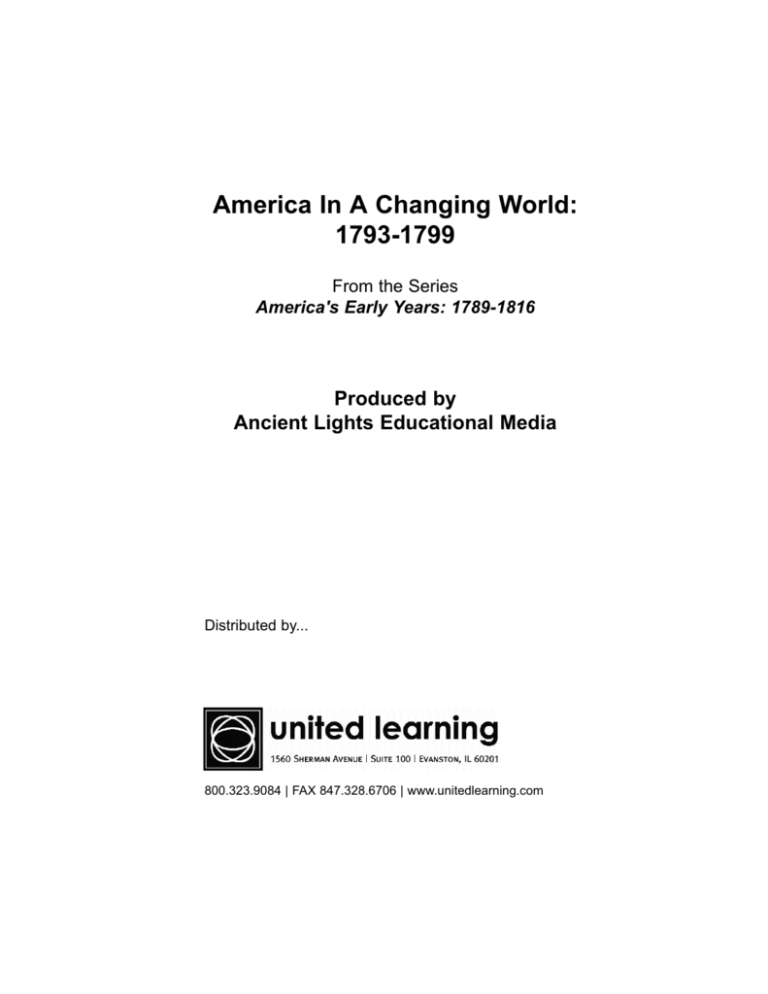
America In A Changing W orld: 1793-1799 From the Series America' s Early Years: 1789-1816 Produced by Ancient Lights Educational Media Distributed by... 800.323.9084 |FAX 847.328.6706 |www.unitedlearning.com This video is the exclusive property of the copyright holder. Copying, transmitting, or reproducing in any form, or by any means, without prior written permission from the copyright holder is prohibited (Title 17, U.S. Code Sections 501 and 506). © 2003 Ancient Lights Educational Media Table of Contents Introduction to the Series . . . . . . . . . . . . .1 Introduction to the Program . . . . . . . . . . . .1 Links to Curriculum Standards . . . . . . . . . .2 Summary of the Program . . . . . . . . . . . . .4 Instructional Notes . . . . . . . . . . . . . . . . . . .4 Pre-Test . . . . . . . . . . . . . . . . . . . . . . . . . . .4 Student/Audience Preparation . . . . . . . . . .5 Student/Audience Objectives . . . . . . . . . . .5 Introducing the Program . . . . . . . . . . . . . .6 View the Program . . . . . . . . . . . . . . . . . . .6 Discussion Questions . . . . . . . . . . . . . . . .6 Description of Blackline Masters . . . . . . . .7 Extended Learning Activities . . . . . . . . . . .8 Answer Key . . . . . . . . . . . . . . . . . . . . . . . .9 Script of Narration . . . . . . . . . . . . . . . . . . .13 This video is closed captioned. The purchase of this program entitles the user to the right to reproduce or duplicate, in whole or in part, this teacher’s guide and the blackline master handouts that accompany it for the purpose of teaching in conjunction with this program, America In A Changing World: 1793-1799. This right is restricted only for use with this program. Any reproduction or duplication in whole or in part of this guide and the blackline master handouts for any purpose other than for use with this program is prohibited. CLASSROOM/LIBRARY CLEARANCE NOTICE This program is for instructional use. The cost of each program includes public performance rights as long as no admission charge is made. Public performance rights are defined as viewing of a video in the course of face-toface teaching activities in a classroom, library, or similar setting devoted to instruction. Closed Circuit Rights are included as a part of the public performance rights as long as closed-circuit transmission is restricted to a single campus. For multiple locations, call your United Learning representative. Television/Cable/Satellite Rights are available. Call your United Learning representative for details. Duplication Rights are available if requested in large quantities. Call your United Learning representative for details. Quantity Discounts are available for large purchases. Call your United Learning representative for information and pricing. Discounts, and some special services, are not applicable outside the United States. Your suggestions and recommendations are welcome. Feel free at any time to call United Learning at 1-800-323-9084. America In A Changing World: 1793-1799 From the Series America's Early Years: 1789-1816 Grades 5-9 Viewing Time: 14 minutes with a one-minute, five-question Video Quiz INTRODUCTION TO THE SERIES This curriculum-based series of programs for grades 5-9 examines the formative years of the American Republic beginning with the presidency of George W ashington and ending with the election of President James Monroe. These programs focus on key events that shaped the history of the United States from 1789 to 1816. Major topics included are: • Launching of the American "ship of state." • Significant contributions of the founding fathers. • The Louisiana Purchase. • The Lewis and Clark Expedition. • The W ar of 1812. • United States expansion and how it affected American Indians and foreign powers. • How industrialization, immigration, expansion of slavery, and westward movement changed the lives of Americans and led toward regional tensions. • The extension, restriction, and reorganization of political democracy. INTRODUCTION TO THE PROGRAM America in a Changing W orld: 1793-1799 is intended for use in grades 5-9. This program examines important events of the fourth through tenth years of the U.S. federal government. Topics presented in this program are: • The invention of the cotton gin and its social effects. 1 • America's neutrality and the war in Europe during the 1790s. • Jay's Treaty and its political effects. • The Treaty of San Lorenzo and its economic effects. • The significance of the Whiskey Rebellion. • The election of President John Adams. • The XYZ Affair. • The Alien and Sedition Acts. • The Virginia and Kentucky Resolutions. • Building the U.S. Navy. • The invention of interchangeable parts. LINKS TO CURRICULUM STANDARDS This program is correlated to the McREL U.S. History Standards, a compendium of national and state standards (www.mcrel.org/about). U.S. History: ERA 3 Revolution and the New Nation (1754-1820s) Standard 8 Understands the institutions and practices of government created during the Revolution and how these elements were revised between 1787 and 1815 to create the foundation of the American political system based on the U.S. Constitution and the Bill of Rights. Benchmarks • Understands the development and impact of the American party system (e.g., social, economic, and foreign policy issues of the 1790s; influence of the French Revolution on American politics; and the rise of the Federalist and Democratic-Republican parties). • Understands influences on the ideas established by the Constitution. • Understands the Bill of Rights and various challenges to it (e.g., the Alien and Sedition Acts, recent court cases involving the Bill of Rights). 2 • Knows the foreign territorial claims in the Western Hemisphere in 1793-1799 and the impact on American foreign policy. • Understands the United States territorial expansion between 1793-1799. • Understands the issues that impacted the lives of farmers in western Pennsylvania during the Whiskey Rebellion. General Topics for the period of 1793-1799 1. Development of the first American party system 2. Role of individuals in history 3. Leaders and leadership styles 4. Development, ideology, and structure of political systems 5. Influence of ideas on society (such as those associated with technological innovation) 6. Historical documents, treaties, and agreements 7. Guarantees and significance of the Bill of Rights 8. United States foreign policy, International diplomacy and relations World History: Era 7 - An Age of Revolutions, 1750-1914 Standard 33 Understands the causes and consequences of the agricultural and industrial revolutions from 1700 to 1850. Benchmarks • Understands the impact of the Industrial Revolution in Europe and the Atlantic Basin. • Understands the effect of the Industrial Revolution on social and political conditions in various regions. 3 SUMMARY OF THE PROGRAM America in a Changing World: 1793-1799 examines some of the practices of government in the United States during the period 1793-1799 by focusing on the extension, restriction, and reorganization of American political democracy. This program looks at technological change and how it affected American industrialization, the expansion of slavery, and the growth of regional divisions between the North and the South. This program also examines issues relating to relations with foreign powers and U.S. expansion. INSTRUCTIONAL NOTES Before presenting this lesson to your students, we suggest that you preview the program, review the guide and the accompanying Blackline Master activities in order to familiarize yourself with their content. As you review the materials presented in this guide, you may find it necessary to make some changes, additions, or deletions to meet the specific needs of your class. We encourage you to do so; for only by tailoring this program to your class will they obtain the maximum instructional benefits afforded by the materials. PRE-TEST Pre-Test is an assessment tool intended to gauge student comprehension of the objectives prior to viewing the program. Explain to the students that they are not expected to get all the answers correct. You can remind your students that these are key concepts that they should focus on while watching the program. 4 STUDENT/AUDIENCE PREPARATION Set up a Learning Center with images relevant to the topics presented in this program, such as significant political leaders, a copy of the Bill of Rights and Jay's Treaty, political party slogans, the United States Navy, the cotton gin, and samples of interchangeable parts. Include highlighted maps depicting sites of important events, boundaries, and political party lines of the 1793-1799 era. STUDENT/AUDIENCE OBJECTIVES After viewing the program and completing the follow-up activities, students should be able to: • Explain how the invention of the cotton gin contributed to the growth of slavery in the South and industrialization in the North. • List the ways in which America's neutrality created longstanding problems with both France and Great Britain and describe the significance of Jay's Treaty in this regard. • Identify how the Treaty of San Lorenzo affected American westward expansion. • Explain the effect of the Alien and Sedition Acts on the restriction of American democracy and describe the purpose of the Virginia and Kentucky Resolutions. • Compare and contrast production and repair of mechanical goods before and after the invention of interchangeable parts. • Identify the ideologies of the Federalist and DemocraticRepublican parties. 5 INTRODUCING THE PROGRAM Duplicate and administer Blackline Master #1, Pre-Test. Remind your students that they are not expected to know all the answers. Suggest that they use these questions as a guide for taking notes on the key concepts while viewing the program. This program should be introduced by talking about the nature of the war in Europe that began after the French Revolution. Explain how America's old treaty with France could have led the United States into the war and how America's neutrality created big problems with both France and Great Britain. Discuss the inspiration for and the effects of the Alien and Sedition Acts. Discuss how America had no established way of dealing with constitutional issues because, in the 1790s, the Supreme Court was not yet on a balanced footing in terms of power with the executive and legislative branches of government. VIEW THE PROGRAM Running Time: 14 minutes plus a one-minute, five-question Video Quiz. Hand out Blackline Master #3, Video Quiz. DISCUSSION QUESTIONS Following the program you may find it helpful to discuss the key concepts as a class. You may choose to use these questions to begin a discussion prior to viewing the program. Avoid answering questions directly; ask students higher-level questions allowing them to discover answers as a group. Feel free to delete questions to suit the needs of your class. 6 1. Why did many people, including Thomas Jefferson and James Madison, believe the Alien and Sedition Acts were unconstitutional? 2. What is a modern-day law that is under fire for constitutional reasons? 3. George Washington disregarded a mutual-defense treaty between France and the United States and this led to an undeclared war between the two countries. Why did he make this choice? 4. Technological changes can have huge effects on how people live. How did the populations decline in the North? In the South? 5. Discuss one recent technological change that affects people's lives significantly. DESCRIPTION OF BLACKLINE MASTERS Blackline Master #1, Pre-Test, is an assessment tool intended to gauge student comprehension of the objectives prior to viewing the program. Blackline Master #2, Post-Test, is an assessment tool to be administered after viewing the program and completing additional activities. The results of this assessment can be compared to the results of the Pre-Test to determine the change in student comprehension before and after participation in this lesson. Blackline Master #3, Video Quiz, is intended to reinforce the key concepts of the program following the presentation of the program. Student awareness that a Video Quiz will be given also helps promote attention to the program presentation. Blackline Master #4, Crossword Puzzle, is a puzzle game based on information presented in the Vocabulary. 7 Blackline Master #5, Timeline and Activity, is a chronological list of events pertaining to important events that occurred between 1793-1799. Blackline Masters #6 and #7, Vocabulary List and Activity, include important names, places, and words relating to events that occurred at this time in history. EXTENDED LEARNING ACTIVITIES Field trips to historic sites are the best way to savor the flavor of the past. Research papers, oral reports, news reports, or PowerPoint® presentations could be done on the following subjects: • How party politics developed in America in the late 1790s. • The war between France and Great Britain and how it came to impact the American shipping industry in the 1790s. • The Whiskey Rebellion: What was it and what were its implications? • The XYZ Affair and how it affected U.S. policy. • The invention of interchangeable parts and its effect on manufacturing. • The effect of the cotton gin on northern industrialization and southern, slave-based agriculture. • Jay's Treaty and its political effects. • The Treaty of San Lorenzo and its economic effects. 8 ANSWER KEY Blackline Master #1, Pre-Test 1. True 2. True 3. True 4. True 5. False. The United States signed a treaty with Spain, not Germany. 6. False. George Washington was referred to as the "Father of his Country." 7. True 8. True 9. False. It was the Treaty of San Lorenzo, not Jay's Treaty. 10. True Blackline Master #2, Post-Test True/False 1. False. Jay's Treaty dealt with issues between the United States and Great Britain. 2. False. America's neutrality was a very unpopular policy in each country. 3. True 4. True 5. True Fill in the Blanks 1. neutral 2. Industrial Revolution 3. bribe, undeclared war 4. John Adams 5. John Jay 6. Thomas Jefferson, Mississippi River 7. George Washington 8. Sedition Act 9 Short Answers Answers will vary, but should include at least two of the following key points. 1. Treaty of San Lorenzo - 1795: Spaniards gave up trying to rule an area of disputed land that had been claimed by both the United States and Spain. Thousands of square miles of new territory were added to the United States, which later became parts of the states of Mississippi and Alabama. The treaty prevented Spanish military forces from interfering with American trading ships on the Mississippi River and it allowed American products and products destined for the American west to be loaded and unloaded in New Orleans without being taxed. 2. The cotton gin: Cotton was in demand, though a difficult process to clean cotton when done by hand. The cotton gin could remove as many seeds simply by turning a crank in a single day as 50 people could do using just their hands. It greatly increased the amount of raw material available to make textiles and cloth production increased in New England. More textile factories were built in the northern states and rural people started to move to industrial cities to find steady work. Cotton rapidly became the most important product of the southern states and the number of slaves working on cotton plantations increased enormously. 3. Jay's Treaty: In 1794, Supreme Court Chief Justice John Jay was sent to London to bring an end to British interference with American trade ships. Britain agreed to turn over forts being used to supply arms to American Indians who were trying to put a stop to U.S. settlement on their lands. These British forts were located in the western Lake Erie region near present-day Detroit and Toledo. The United States agreed to stop carrying goods between France and her colonies. France was concerned 10 Jay's Treaty showed that America was far from neutral because of U.S. willingness to give in to British demands. As a result, an undeclared war broke out between the United States and France. 4. Whiskey Rebellion - 1794: Pennsylvania and Kentucky farmers raised wheat, corn, and rye and they used some of the grain to make whiskey. United States law said it was legal; however, whiskey producers were required to pay a tax. This tax was an important source of income for the federal government back in the 1790s. Farmers refused to pay the tax and committed violence against the federal tax collectors, setting off what has come to be called the Whiskey Rebellion. To put an end to the rebellion, President Washington sent 15,000 U.S. troops into the region, which forced farmers to pay the taxes. American government made it clear that it would not tolerate activities that violated national laws. 5. Interchangeable parts: Before 1798, mechanical devices were made by blacksmiths, a very time-consuming process. In 1798, the inventor of the cotton gin, Eli Whitney, developed a new manufacturing method based on making nearly identical devices built with interchangeable parts. Whitney came up with his new method while filling a rush order for 10,000 guns called muskets for the U.S. military. This process allowed for more guns to be manufactured a lot faster than the old handmade models. Interchangeable parts led to the mass production of a wide range of mechanical devices and, as a result, American industry was soon revolutionized. Blackline Master #3, Video Quiz 1. False. Jay's Treaty dealt with issues between the United States and Great Britain. 2. True 3. False. The Whiskey Rebellion was sparked by a refusal to pay federal taxes on whiskey. 11 4. True 5. False. American neutrality was a very unpopular policy in each country. Blackline Master #4, Crossword Puzzle 1 2 J C O T T O N G I 3 W N 4 H 5 I N D U S T R I 7 8 B R 10 I 9 I S N K J E E O S Y H S N E U T R A L Y H N J 6 T A L R E V O L U T O N S A N L O R E N Z O I A B D E N T E R C H A N G E A B L E P A R T S M S Blackline Master #5, Timeline Activity A. XYZ Affair, 1 Election of John Adams, 2 B. Invention of the cotton gin, 1 Alien and Sedition Acts, 2 C. First organized labor protest, 2 Virginia and Kentucky Resolutions, 1 D. First intercity turnpike, 1 Death of George Washington, 2 E. Whiskey Rebellion, 1 Treaty of San Lorenzo, 2 12 Blackline Master #7, Vocabulary Activity 1. unconstitutional 2. sedition 3. interchangeable parts 4. concessions 5. bribes SCRIPT OF NARRATION It was in the year 1793 that George Washington began his second and last term as U.S. President. During his first term in office, Washington had focused on getting the new federal government up and running. But, as the dawn of the 19th century drew nearer, political problems at home and war in Europe increasingly challenged the United States government. At the same time, an industrial revolution was occurring and it was bringing about big changes in the way that goods were manufactured. This revolution set off a chain of events that would come to have an enormous impact on the U.S. economy. And it would also cause great differences to develop between the way people lived in the increasingly industrial northern states and the mostly agricultural southern states. The Invention of the Cotton Gin, 1793 In 1793, at the time George Washington took the oath of office for president a second time, the Rhode Island factory seen here, was already into its third year of operation. It was the first factory in America to use water-powered machines to "spin" cotton thread for weaving. Yet even though the demand for cotton cloth was great back then, cotton had not been very widely used in textiles. That was because cotton fibers are contained in the plant's seedpods, and before the fiber can be spun into thread, the seeds must be removed. "Cleaning" cotton is a very slow process when done by hand. But after 1793, the year Eli Whitney of Connecticut invented a machine called the 13 cotton gin, simply by turning a crank it was possible to remove as many seeds from "raw" cotton in a single day as 50 people could do using just their hands. Because the cotton gin greatly increased the amount of raw material available to make textiles, cloth production increased in New England. More textile factories were built in the northern states and rural people started to move to industrial cities to find steady work. Cotton rapidly became the most important product of the southern states and the number of slaves working on cotton plantations increased enormously. And that was how a simple invention for removing seeds from raw cotton came to have a tremendous effect on the lives of millions of people. America and the War in Europe, 1793 The same year the cotton gin was invented, the nation of France was fighting a major war in Europe. France had asked for U.S. military support but George Washington decided America should remain neutral. In other words, he did not want his nation to take sides in the conflict. Washington made this decision in spite of the fact that America had signed a defense treaty with the royal government of France in order to secure their crucial help during the Revolutionary War. However, by 1793, France's monarchy had been overthrown and a new government was in place. Besides that, France's main enemy, Great Britain, had become America's biggest trading partner and the United States could not afford to lose British business. In the end, the U.S. policy of neutrality caused big problems and angered both the French and the British. As a result, Britain and France captured American ships and U.S. sailors were often forced to work as crewmembers on British vessels. Jay' s Treaty, 1794 In 1794, Supreme Court Chief Justice John Jay was sent to London on a diplomatic mission. Its main goals were to 14 bring an end to British interference with American trade ships and to clear up a variety of problems, some dating back to the end of the Revolutionary War. Under the treaty that Jay finally negotiated, Britain agreed to turn over forts being used to supply arms to American Indians who were trying to put a stop to U.S. settlement on their lands. These British forts were located in the western Lake Erie region near present-day Detroit and Toledo. Also under Jay's Treaty, the United States agreed to stop carrying goods between France and her colonies. In exchange, the United States got a few minor concessions from Britain to limit its interference with American trade ships. However, as far as France was concerned, Jay's Treaty merely showed that America was far from neutral because of its willingness to give in to British demands. And as a result, an undeclared war broke out between the United States and France. The Whiskey Rebellion, 1794 As the United States government worked at solving its problems with France and Britain, trouble developed at home in the normally peaceful farm country of western Pennsylvania and Kentucky. People in these areas raised wheat, corn, and rye and they used some of the grain to make whiskey. It was perfectly legal to make whiskey. But U.S. law said that persons who did so had to pay a tax. In fact, tax on alcohol was an important source of income for the federal government back in the 1790s. But many farmers refused to pay the tax. They even committed violence against the federal tax collectors, setting off what has come to be called the Whiskey Rebellion. To put an end to the rebellion, President Washington sent 15,000 U.S. troops into the region. This large show of force soon convinced the farmers to pay the taxes. And the rebels also were required to sign the document seen here, in which they agreed to respect the laws of the United States. And so by taking swift military action against the 15 Whiskey Rebellion, the American government made it clear that it would not tolerate activities that violated national laws. The Treaty of San Lorenzo, 1795 One year after the Whiskey Rebellion, negotiations on some important issues were underway here in the kingdom of Spain between royal officials and the representatives of the United States. Under the agreement that was finally worked out, called the Treaty of San Lorenzo, the Spaniards gave up trying to rule an area of disputed land that had been claimed by both the United States and Spain. And as a result, thousands of square miles of new territory were added to the United States. This land later became parts of the states of Mississippi and Alabama. In addition, the treaty prevented Spanish military forces from interfering with American trading ships on the Mississippi River. Even beyond that, the Treaty of San Lorenzo allowed American products and products destined for the American west to be loaded and unloaded here in New Orleans, which was then under Spanish control, without being taxed. Having free access to the Mississippi River proved to be extremely important to America because it increased both trade and settlement in the western region of the country. Tennessee Statehood & John Adams Elected U.S. President, 1796 The year after the Treaty of San Lorenzo was enacted, Tennessee joined the Union as the 16th state. 1796 was also the year America's third presidential election took place. This time George Washington chose not to run. John Adams, who was vice-president under Washington, won the election of 1796 by only three electoral votes. According to the laws of that time, whoever received the second-highest number of electoral votes automatically became vice-president. In that election, Thomas Jeffer16 son was runner-up and so he got the job. Unfortunately the new vice-president and president belonged to opposing political parties. As a result, they had very different views as to how the American people should be governed. Conflicts and Resolutions of 1797 and 1798: The XYZ Affair, Building a U.S. Navy, Alien & Sedition Acts, Virginia & Kentucky Resolutions During his first year in office, President John Adams sent representatives to Paris to try to negotiate an end to the undeclared war between America and France. But the French demanded that the United States pay them bribes before they would even start talking. This event, that came to be called the XYZ Affair, insulted the American negotiators so much that they sailed back home and saw to it that old treaties with France were repealed. That same year, in response to the growing threat of war, the ship seen here, the U.S.S. Constellation, was built. The Constellation had 36 cannons and was the first U.S. navy vessel ever to capture a foreign warship. The ship that it captured belonged to France. As the U.S. Navy was busy putting together its first fleet, President Adams's Federalist Party used its majority in Congress to pass a set of laws called the Alien and Sedition Acts designed to increase their political power. The three Alien Acts subjected new immigrants to unfair treatment and deprived many people who opposed the Federalists of their right to vote, while the Sedition Act made it illegal to criticize the U.S. government. And when one newspaper editor suggested that some of John Adams' actions were a lot more like those of a king than a president, the editor was thrown in jail. 17 James Madison, the man who composed the Bill of Rights, was one of the most outspoken critics of Federalist attempts to undermine basic American freedoms. Madison and Thomas Jefferson both helped write the Virginia and Kentucky Resolutions, which proposed that the Alien and Sedition Acts be ignored because they violated the U.S. Constitution. They suggested that states should always have the right to void unconstitutional federal laws. The Invention of Interchangeable Parts, 1798 While America debated issues of state rights, a basic change took place in the way goods were manufactured. Before 1798, mechanical devices from guns to clocks to locks were made by blacksmiths, one at a time by hand. As a result, every mechanical device was unique. But in 1798, the inventor of the cotton gin, Eli Whitney, developed a new manufacturing method based on making nearly identical devices built with interchangeable parts. Whitney came up with his new method while filling a rush order for 10,000 guns called muskets for the U.S. military. The new muskets had a big advantage over older models because they could be easily repaired. Not only that, the new guns could be manufactured a lot faster than the old handmade models and that was a big bonus during times of war. The concept of interchangeable parts led to the mass production of a wide range of mechanical devices and, as a result, American industry was soon revolutionized. George Washington's Death, Napoleon Seizes Power in France, 1799 During the final year of the 18th century, George Washington, the man who had come to be called the "Father of his Country," died at the age of sixty-seven from a throat infection, an illness that could have easily 18 been cured using modern medicines. That same year a man called Napoleon Bonaparte seized power in France. This change in leadership made it possible for John Adams to finally work out a peace deal with the French just as his term of office was ending. Only four years later, a new American president, Thomas Jefferson, helped work out another deal with Napoleon that pushed the boundaries of the new nation far to the west of the Mississippi River and doubled the size of the United States. Video Quiz 1. True or False? Jay's Treaty helped solve problems of state's rights. 2. True or False? The Sedition Act made it illegal to criticize the U.S. government. 3. True or False? Conflicts over cotton gins led to the Whiskey Rebellion. 4. True or False? The Treaty of San Lorenzo helped open up the western part of America to trade. 5. True or False? In the 1790s, America's neutrality was a popular policy in both France and Great Britain. 19 20


